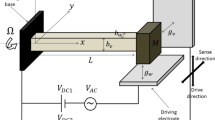Abstract
Over the past twelve years, ideas and methods from nonlinear dynamics system theory, in particular, group theoretical methods in bifurcation theory, have been used to study, design, and fabricate novel engineering technologies. For instance, the existence and stability of heteroclinic cycles in coupled bistable systems has been exploited to develop and deploy highly sensitive, low-power, magnetic and electric field sensors. Also, patterns of behaviour in networks of oscillators with certain symmetry groups have been extensively studied and the results have been applied to conceptualize a multifrequency up /down converter, a channelizer to lock into incoming signals, and a microwave signal generator at the nanoscale. In this manuscript, a review of the most recent work on modelling and analysis of two seemingly different systems, an array of gyroscopes and an array of energy harvesters, is presented. Empirical values of operational parameters suggest that damping and external forcing occur at a lower scale compared to other parameters, so that the individual units can be treated as Hamiltonian systems. Casting the governing equations in Hamiltonian form leads to a common approach to study both arrays. More importantly, the approach yields analytical expressions for the onset of bifurcations to synchronized oscillations. The expressions are valid for arrays of any size and the ensuing synchronized oscillations are critical to enhance performance.





Similar content being viewed by others
References
William Rowan Hamilton, Philosophical transactions of the Royal Society, pp 247–308 (1834)
William Rowan Hamilton, Philosophical Transactions of the Royal Society, pp 95–144 (1835)
M E Tuckerman, B J Berne, and G J Martyna, J. Chem. Phys. 94(10), 6811 (1991)
N E Leonard and J E Marsden, Physica D 105(1–3), 130 (1997)
A Bulsara, V In, A Kho, A Palacios, P Longhini, S Baglio, and B Ando, Meas. Sci. Technol. 19, 075203 (2008)
V In, A Bulsara, A Palacios, P Longhini, A Kho, and J Neff, Phys. Rev. E 68, 045102 (2003)
V In, A Palacios, A Bulsara, P Longhini, A Kho, Joseph Neff, Salvatore Baglio, and Bruno Ando, Phys. Rev. E 73(6), 066121 (2006)
A Palacios, J Aven, P Longhini, V In, and A Bulsara, Phys. Rev. E 74, 021122 (2006)
R J McDonald and N Sri Namachchivaya, Dynam. Stabil. Syst. 14(4), 357 (1999)
R J McDonald and N Sri Namachchivaya, J. Sound Vib. 255(4), 635 (2002)
R J McDonald, N Sri Namachchivaya, and W Nagata, Fields Institute Commun. 49, 79 (2006)
N Sri Namachchivaya and W Nagata, Proc. R. Soc. London A 454, 543 (1998)
L Kocarev and G Vattay, Complex dynamics in communication networks (Springer, New York, 2005)
Y Susuki, Y Takatsuji, and T Hikihara, IEICE Trans. Fundamentals E92-A(3), 871 (2009)
C Acar and A M Shkel, MEMS Vibratory gyroscopes: Structural approaches to improve robustness (Springer, 2009)
M S Grewal, L R Weill, and A P Andrews, Global positioning systems, inertial navigation, and integration (Wiley-Interscience, 2007)
R Rogers, Applied mathematics in integrated navigation systems (American Institute of Aeronautics and Astronautics, 2007)
S P Beeby, M J Tudor, and N M White, Meas. Sci. Technol. 17, R175 (2006)
F Peano, G Coppa, C Serazio, F Peinetti, and A D Angola, Math. Comput. Model 43, 1412 (2006)
V Huy, Ring of vibratory gyroscopes with coupling along the drive axis, Ph.D. thesis (San Diego State University, 2011)
Cenk Acar and Andrei Shkel, MEMS vibratory gyroscopes: Structural approaches to improve robustness (Springer Verlag, 2009)
Vladislav Apostolyuk, in: MEMS /NEMS (Springer, 2006), pp. 173–195
Vladislav Apostolyuk and Francis EH Tay, Sensor Lett. 2(3–4), 3 (2004)
URL http://en.wikipedia.org/wiki/Coriolis_effect, (2013)
B Dionne, M Golubitsky, and I Stewart, Nonlinearity 9, 575 (1996)
Vu Huy, Antonio Palacios, Visarath In, Patrick Longhini, and Joseph D Neff, Chaos 21(1), 013103 (2011)
Vu Huy, Antonio Palacios, Visarath In, Patrick Longhini, and Joseph D Neff, Phys. Rev. E 81(3), 031108 (2010)
P-L Buono, B Chan, A Palacios and V In, Physica D (under review) (2014)
S Roundy, P K Wright, and J M Rabaey, Energy Scavenging for wireless sensor networks (Kluwer Academic, Boston, 2004)
Acknowledgements
BC and AP were supported by the Complex Dynamics and Systems Programme of the Army Research Office, supervised by Dr Samuel Stanton, under grant W911NF-07-R-003-4. AP was also supported by the ONR Summer Faculty Research Programme, at SPAWAR Systems Centre, San Diego. VI acknowledges support from the Office of Naval Research, Code 30 under the programme managed by Dr Michael F Shlesinger. P-LB would like to thank Alberto Alinas for checking some early calculations as part of a student project. P-LB acknowledges the funding support from NSERC (Canada) in the form of a Discovery Grant.
Author information
Authors and Affiliations
Corresponding author
Rights and permissions
About this article
Cite this article
BUONO, PL., CHAN, B., PALACIOS, A. et al. A Hamiltonian approach to model and analyse networks of nonlinear oscillators: Applications to gyroscopes and energy harvesters. Pramana - J Phys 85, 929–945 (2015). https://doi.org/10.1007/s12043-015-1079-4
Published:
Issue Date:
DOI: https://doi.org/10.1007/s12043-015-1079-4




